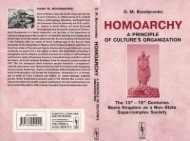L. Fituni, I. Abramova Resource Potential of Africa and Russia's ...
L. Fituni, I. Abramova Resource Potential of Africa and Russia's ...
L. Fituni, I. Abramova Resource Potential of Africa and Russia's ...
Create successful ePaper yourself
Turn your PDF publications into a flip-book with our unique Google optimized e-Paper software.
have been recalculated on the basis <strong>of</strong> different parity, or even in<br />
accordance with the USSR State bank exchange rate for national<br />
currencies <strong>of</strong> <strong>Africa</strong>n countries.<br />
It was not a rare case that Moscow would “make a gift” <strong>of</strong> unused<br />
military reserves (it could be armaments, tanks, trucks, etc.)<br />
whose time <strong>of</strong> warehouse conservation expired or which became<br />
morally old. Those would be fully functioning, unused items (say,<br />
cannon shells, or mortars, kept somewhere in East Germany) whose<br />
utilization or even transportation to utilization factories in Siberia<br />
would have been more costly than selling them at a huge discount<br />
<strong>and</strong> on long term credit terms, or, sometimes, as mentioned above,<br />
even <strong>of</strong>fering them as a gift. Such practices were not limited to military<br />
hardware either, but would include many export items <strong>of</strong> Soviet-made<br />
machinery or means <strong>of</strong> transportation.<br />
The complex system <strong>of</strong> multiple exchange rates <strong>and</strong> parities<br />
should not create an impression that the calculations were totally<br />
subjective <strong>and</strong> had no economic foundations under them. Unfortunately,<br />
with time technical “foreign currency” specialists <strong>of</strong> the Soviet<br />
system pass away <strong>and</strong> in some cases with them disappears the<br />
true knowledge about how, why <strong>and</strong> on what basis this or that calculation<br />
had been done, or even the methodologies <strong>of</strong> such calculations.<br />
Besides this, after the demise <strong>of</strong> the Soviet Union, the new liberal<br />
authorities were not too keen on making the precise figures<br />
from Soviet ledges <strong>and</strong> account books known to outsiders. Within a<br />
number <strong>of</strong> years a significant part <strong>of</strong> former Soviet claims on the<br />
Third world countries were sold at discount, first to a number <strong>of</strong> favored<br />
intermediaries, who then resold them at premium on secondary<br />
debt markets. This was allegedly the fate <strong>of</strong> parts <strong>of</strong> Ghanaian,<br />
Ug<strong>and</strong>an, South Yemeni <strong>and</strong> other liabilities to the USSR.<br />
The sellers were companies with access to the first Ye.Gaidar<br />
government <strong>of</strong> Russian Federation. The buyers were <strong>of</strong>ten sham<br />
companies working in the interest <strong>of</strong> major western financial groups<br />
<strong>and</strong> transnational banks. The looted property <strong>of</strong> the former Soviet<br />
Union later became the foundation capital <strong>of</strong> newly emerging private<br />
commercial banks in democratic Russia. Some <strong>of</strong> those banks<br />
148







